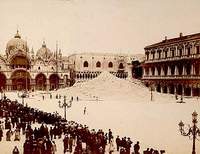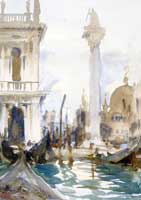|
Campanile
(kämpän´l) the name
derives from the Italian word for bell and means "bell tower". They
were constructed in connection with a church or town hall and served as
a belfry, watch tower, and often functioned as a civic monument. Generally
they are free-standing and detached from the church.
Originating in the 6th century, the
campaniles were the earliest church towers in Europe and were generally
circular in shape (such as the later Leaning
Tower of Pisa, 1173) but more often the square kind became most common.
This campanile, built in the 10th
century, is the tallest structure in Venice at 99 meters (or 325 feet)
tall. It also served as a lighthouse to the ships coming in.

In July, 1902, the whole thing collapsed.
Luckily it didn't cause any damage to the Bacilica  or the Libreria
or the Libreria (the
Logetta (the
Logetta  faired less well). While Sargent was there beyond 1902, his paintings
show the noteable absence of the tower.
faired less well). While Sargent was there beyond 1902, his paintings
show the noteable absence of the tower.

Venice
1902?
It was subsequently rebuilt -- not
sure exactly what year.
"Inside the tower there are 5 large
cast iron
bells. Each has a name and a purpose;
Marangona
rang mornings and evenings at the beginning and end of the work day, Maleficio
rang for capital executions, Nona rang at the 9th hour, Trottiera
called magistrates to meetings in the Palazzo Ducale ,
and the bell of Pregadi called senators to the Palace." ,
and the bell of Pregadi called senators to the Palace."
(History
and Curiosity)
Notes:
|
